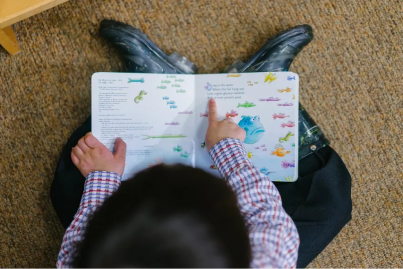During phonics instruction, children learn to sound out or “decode” words. With enough practice, decoding turns into sight word recognition. Sight words are defined as any word that can be recognized instantaneously at first sight, without the need to decode it.
High-frequency words are defined as the most commonly occurring words found in texts and books. Some high-frequency words are regular, meaning they follow common phonics patterns.
Irregular words, however, do not follow common phonics patterns. An example of an irregular high-frequency word is ‘of,’ in which the <f> makes a /v/ sound—which is not a regular phonics pattern.
The two terms “sight words” and “high-frequency words” are often used incorrectly or interchangeably, which can lead to confusion. It can also lead to ineffective phonics instruction methods.
What is the real difference between sight words and high-frequency words? Let’s clarify each term so you can master your approach to proper instruction. Keep reading to learn the difference and the relationship between sight words and high-frequency words in children’s literacy development.
How Does a Word Become a Sight Word?
As children develop sight word recognition, their reading fluency and comprehension improve. Students learn to recognize sight words through the process of orthographic mapping.
- Children learn letter-sound correspondences.
- Readers use their knowledge of letter-sound correspondences to decode new words.
- Each time a student decodes the same word, their brain “maps” the written word to the spoken word and its meaning.
- Repeated orthographic mapping of the same word reinforces that word in the child’s memory.
- After so many repetitions, the brain instantly maps words when reading texts.
Once new words are committed to a child’s memory, they can focus their cognitive efforts on comprehending the words rather than stumbling over frequently encountered ones.
What are High-Frequency Words?
As the name implies, high-frequency words are words that appear frequently in written texts. Students encounter them repeatedly as their reading abilities progress. In fact, 100 high-frequency words make up 50% of the words we read and write in English!
As students encounter frequently-appearing words in their reading materials, their familiarity with the words’ phonetic patterns supports their fluency and accurate reading. Eventually, high-frequency words will become sight words that students can recognize automatically. This is an important goal and milestone in phonics instruction.
How Do Kids Learn to Read Irregular High-Frequency Words
Some irregularly-spelled words appear frequently in texts. These words can be tricky for children to “sound out” using basic phonics rules on their own. Teachers must take a different approach.
While there is some debate in reading research about how children learn to read irregular words, there are generally two approaches used in instruction.
- The “Heart Word Magic” approach focuses on decoding letter sounds, while explicitly pointing out the irregular sound parts that should be memorized “by heart.”
- The Paired Associate Learning approach emphasizes word memorization. It pairs the visual word with the pronunciation of that word. However, this is not useful for all words as rote memorization can become a challenge or even a disadvantage for learners.
Are Sight Words and High-Frequency Words the Same Thing?
By knowing the difference and the relationship between sight words and high-frequency words, teachers ensure well-rounded phonics instruction. The importance of explicit, systematic phonics instruction cannot be overstated in the context of reading development, no matter which type of words students are learning to decode. Extensive research demonstrates that a strong foundation in systematic phonics is crucial to long-term reading success.
Phonics Activities to Master High-Frequency Words as Sight Words
What are some effective ways teachers and parents can introduce (and practice) high-frequency words when their child is learning to read? Take a few of these pointers.
Irregular High-Frequency Words
Teaching irregular words that occur frequently should not be the primary focus of reading instruction. Knowing these words well does play a role in developing fluency and efficiency. Word-reading instruction blends explicit phonics practice with repeated exposure to build automatic word recognition over time.
Effective strategies for explaining irregular high-frequency words include:
- Word Builders: Use movable letter tiles or Elkonin boxes to let students sound out new words and explain the irregular portion of the word.
- Decodable Books: Having students read decodable texts that contain targeted high-frequency words helps with repetition, encouraging them to apply their phonics knowledge while decoding new words.
- Break Down Irregular Words: Introduce an irregular word to students (such as “said”). Have them underline the sounds they know, and circle the sounds they don’t know. In this case, /ai/ is likely unfamiliar as the word ‘said’ sounds like it has an /e/ in the middle. Students underline /s/ and /d/ but circle /ai/, and the teacher explains this irregular word in full.
Regular High-Frequency Words
High-frequency words should be taught primarily through explicit, systematic phonics instruction. As students encounter these common words in their reading materials, they should be encouraged to apply their phonics knowledge to decode and analyze the words’ patterns.
Incorporate high-frequency word study into phonics lessons by having students blend the sounds and practice reading and spelling the words in context. Provide decodable texts that contain the high-frequency words being studied, allowing students to reinforce their phonics skills while gaining repeated exposure to these words.
Help Kids Learn to Read Through Phonics
Providing a strong foundation in phonics is crucial for raising skilled and confident readers. This evidence-based approach aligns with the science of reading and sets children on the path to long-term learning and success.
To learn more about implementing accurate, research-based phonics methods in your classroom or home, explore the wealth of resources available at Phonics.org.

